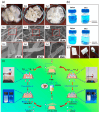Sustainability in Membrane Technology: Membrane Recycling and Fabrication Using Recycled Waste
- PMID: 38392679
- PMCID: PMC10890584
- DOI: 10.3390/membranes14020052
Sustainability in Membrane Technology: Membrane Recycling and Fabrication Using Recycled Waste
Abstract
Membrane technology has shown a promising role in combating water scarcity, a globally faced challenge. However, the disposal of end-of-life membrane modules is problematic as the current practices include incineration and landfills as their final fate. In addition, the increase in population and lifestyle advancement have significantly enhanced waste generation, thus overwhelming landfills and exacerbating environmental repercussions and resource scarcity. These practices are neither economically nor environmentally sustainable. Recycling membranes and utilizing recycled material for their manufacturing is seen as a potential approach to address the aforementioned challenges. Depending on physiochemical conditions, the end-of-life membrane could be reutilized for similar, upgraded, and downgraded operations, thus extending the membrane lifespan while mitigating the environmental impact that occurred due to their disposal and new membrane preparation for similar purposes. Likewise, using recycled waste such as polystyrene, polyethylene terephthalate, polyvinyl chloride, tire rubber, keratin, and cellulose and their derivates for fabricating the membranes can significantly enhance environmental sustainability. This study advocates for and supports the integration of sustainability concepts into membrane technology by presenting the research carried out in this area and rigorously assessing the achieved progress. The membranes' recycling and their fabrication utilizing recycled waste materials are of special interest in this work. Furthermore, this study offers guidance for future research endeavors aimed at promoting environmental sustainability.
Keywords: membrane recycling; sustainable membranes; waste recycling; waste-derived membranes.
Conflict of interest statement
The authors declare no conflict of interest.
Figures










References
-
- van Vliet M.T.H., Jones E.R., Flörke M., Franssen W.H.P., Hanasaki N., Wada Y., Yearsley J.R. Global water scarcity including surface water quality and expansions of clean water technologies. Environ. Res. Lett. 2021;16:024020. doi: 10.1088/1748-9326/abbfc3. - DOI
-
- Lavrnić S., Zapater-Pereyra M., Mancini M.L. Water Scarcity and Wastewater Reuse Standards in Southern Europe: Focus on Agriculture. Water Air Soil Pollut. 2017;228:251. doi: 10.1007/s11270-017-3425-2. - DOI
Publication types
Grants and funding
LinkOut - more resources
Full Text Sources

